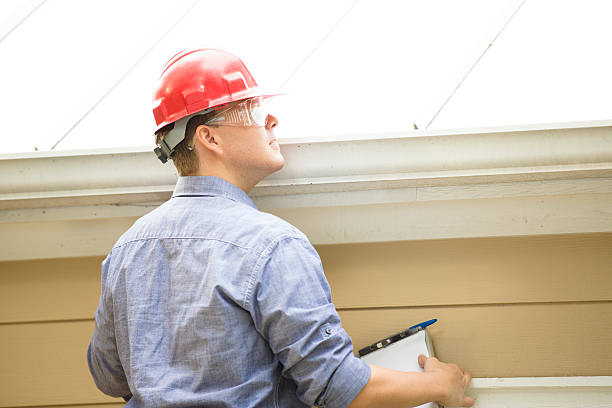When it comes to roof inspections, a keen eye and a little know-how can make all the difference between a secure, cozy home and one prone to leaks and costly repairs. Truly, your roof is like the hero of your house, but like any hero, it needs a check-up now. It is the best way to ensure it remains up to the task.
In this guide, we’ll take you through the basics of inspecting your roof so you can spot potential issues before they become major headaches.
What Is a Roof Inspection?
A roof inspection is similar to a thorough check-up for your home’s vital mechanical system. Despite its seemingly passive nature, your roofs, like your HVAC, plumbing, and electrical systems, is crucial in safeguarding your abode. Regular roof inspections are essential to ensure its reliability and functionality.
During a roof inspection, a trained professional examines all facets of your roof, inside and out, leaving no shingle unturned. This meticulous evaluation aims to assess your roof’s current performance and pinpoint any potential issues that require attention. Furthermore, roof inspections are also sought to certify a roof’s quality and expected lifespan, particularly when buying or selling a property.
In practice, if necessary, a certified inspector visits your home, gaining access to various areas, including the attic and garage. Once the inspection concludes, you’ll receive a comprehensive inspection report detailing any damage or red flags.
Detailed Guide to Inspecting a New Roof
A thorough roof inspection includes a comprehensive examination of both the roof’s interior and exterior. To do this, you’ll need to embark on an inside-out journey to identify any potential issues.
Below is a practical checklist that outlines the steps to inspecting a new roof.
Interior Inspection
This step offers the advantage of revealing underlying structural issues without ascending onto the roof. It is an ideal starting point for identifying holes and leaks, as signs like sunlight penetration and dripping water are more evident within the attic before they manifest inside your home.
During the interior roof inspection, pay close attention to:
- Sunlight Infiltration: Look for any beams of sunlight penetrating through the roof.
- Leaks and Dripping Water: Check around chimneys and vents for signs of water intrusion and leaks.
- Roof Sheathing: Examine for cracks or damage in the roof sheathing.
- Moisture and Mold: Detect any presence of mold, wet spots, or excessive moisture.
- Insulation and Nails: Inspect for wet insulation and any frosted nails.
- Ventilation: Ensure proper attic intake vents and examine kitchen and bathroom exhaust vents for ventilation issues.
- Structural Integrity: Look for any signs of sagging in the roofing deck.
- Ventilation: Verify that your roof has adequate ventilation.
Remember, not all roof damage is visible from the exterior. This makes interior inspection vital to maintaining a healthy and durable roof.
Your diligent assessment of the attic, ceilings, and walls may reveal cracks, holes, light infiltration, mildew, pests, rot, and water stains. It can help you address problems before they worsen.
Exterior Inspection
When it comes to the exterior inspection of your roof, we advise that you employ the services of a professional roofing contractor like TheRoofPro. Professional roofing contractors have the expertise and specialized tools to ensure a thorough and efficient assessment of your roof’s external components.
During an exterior roof inspection, the following key areas are scrutinized:
- Gutters and Downspouts: Check for clogs and damage, impeding proper drainage.
- Roof Sagging: Examine for any signs of structural deformation.
- Shingle Condition: Look out for cracks, breaks, missing granules, loose or absent shingles.
- Nail Integrity: Ensure that nails are securely placed and not exposed, loose, or popped.
- Flashing: Inspect for rusted, damaged, corroded, or missing flashing, which can lead to water infiltration.
- Fascia Board: Detect any rot on the fascia board.
- Chimney: Check for cracks or damage around chimneys.
- Caulking: Ensure that caulking is intact and not damaged or missing.
- Siding: Assess the condition of the siding to maintain the overall integrity of your home’s exterior.
In addition, look for any general damage, missing materials, discoloration caused by moss, rust, or water infiltration, and signs of cracks, leaks, or pests.
Structural Inspection
The structural inspection phase of your roofing assessment is crucial for ensuring your roof system’s overall stability and health. During this examination, a roofing inspector focuses on the critical components that uphold your roof and its structural integrity.
Key aspects of a structural inspection include:
- Sagging roof assessment: The inspector checks for any indications of a sagging roof, which may include:
- Absent or damaged collar ties
- Absent or damaged rafter ties
- Deteriorated or fractured rafters or trusses
- Leaning or tilting exterior walls
- Sagging ceilings
- Soffit and fascia examination: Here, the inspector examines the condition of the soffit and fascia. This check is essential because the soffit and fascia components play a vital role in protecting the roof’s structure and providing ventilation.
- Gutter system inspection: The gutter system is examined for proper functionality and to ensure it effectively channels water away from the roof.
- Chimneys and skylights: Visible signs of damage in chimneys or skylights are checked to identify any potential structural issues.
A thorough structural inspection is essential to ensure the longevity and stability of your roof.
Conclusion
Don’t leave your roof’s well-being to chance. Trust in RoofPro‘s commitment to excellence in roofing services. Contact us today and ensure your roof protects your home for years to come. Your peace of mind starts with us.


